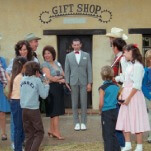The Wire: "More With Less"

Before getting started, a couple of notes:
1. New episodes of The Wire are available on HBO On Demand a week before they’re officially broadcast. This means that some or many of you will be privy to information in future episodes. Needless to say, DO NOT give away any spoilers in the comment section. Specific discussion of the current episode or previous episodes of the show is welcome, of course, and speculation about the future is also fine. Just don’t give anything away or I’ll delete with extreme prejudice.
2. I’m one of those annoying robots who consider The Wire the greatest drama in TV history, so unless things go completely awry in a way they haven’t in the previous four seasons, an “A” grade will be pretty rote. I’ll just be doing my best to illuminate its greatness and hopefully the rest of you can chip in, too. They’ll be a lot of discuss every week and no matter how long-winded these recaps get, I’m sure they’ll only be just the tip of the iceberg. I trust you folks will fill in the gaps.
So let’s get to it…
Among the many things that separate The Wire from other TV dramas is the way that creator David Simon eases into a season. There are never any big setpieces or incidents to grab viewers by the lapels—the one possible exception being the bodies on the dock in Season Two—but a confident, methodical patience in revealing up one story thread after another. This probably explains why some people have expressed problems getting into the show; without anything particularly attention-grabbing at the start, they have to sort through a couple dozen major players and the extraordinarily intricate plotting that binds them together.
For my money, tonight’s episode had maybe the show’s best soft opening to date—or at least since McNulty’s “Snotboogie” monologue to open the series. Bunk’s speech about how the right to remain silent is overrated sounds at first like a nugget of wisdom, but it’s the start of a hilarious gambit to pit a couple of unseasoned young hoods against each other. For the price of two Quarter Pounders, “big fries,” and McDonaldland cookies, Bunk and his cohorts are able to divide and conquer, which seems absurd on its face—as does the copy machine lie-detector test a few minutes later—but perfectly in line with the show’s general view of humanity. In the world of The Wire, there are no loyalties and everyone has a price, even if that price is a value meal at Mickey D’s. Or maybe, in the words of one veteran detective, “Americans are a stupid people, by and large.” Whatever the case, it’s entirely believable that the solidarity between these kids could be broken by so little as a mouthful of fries.
The title of the episode, “More With Less,” pretty much says it all. And what’s remarkable about the hour is that it continues coming back to that theme in every area—the cops, the drug dealers, and the journalists—while still moving the overall story forward. I don’t know a single person in the working world who doesn’t know what doing “more for less” is all about: It’s the nature of the capitalist system—and the government institutions that support it—that we’ve forced to make the most out of limited staff, limited resources, and limited pay. Budget freezes, cutbacks, and general belt-tightening are par for the course, yet the need for employees to produce under the squeeze is still there. Here, the mayor still needs his crime stats, cops still need their collars, journalists still need to put out copy, and drug dealers still have to work their corners, even if they’re getting less of a cut than they have in the past.
No institution has been damaged more profoundly by “more with less” than the Fourth Estate, and Simon, who spent 14 years as a crime reporter for the Baltimore Sun, knows that world extremely well. With the move to the Internet siphoning off circulation numbers everywhere—and media companies buying up once-proud papers and sucking the life out of them—journalism has suffered immensely. Needless to say, that’s a dangerous development, since good reporting is part of what protects the people from tyranny and abuse from those in power. Of course, those poor bastards who remain in the field still have jobs to do, and the episode goes into gratifying detail about how newspapers get assembled every week, as well as the salty language and rock-bottom morale that typifies the modern newsroom. Simon knows this world inside and out, from the smoke breaks where veterans air their grievances to the budget meetings where stories are pages are planned (and stories are killed) to the way that a blink-or-you’ll-miss-it property swap can develop into a major scoop.
And presiding over it all is Clark Johnson, as veteran Sun city desk editor Gus Haynes, and I can’t imagine a better person for the role. Johnson directed the first two episodes of The Wire and has done some directing work for the also-excellent The Shield, but he’s remembered best as a series regular on Homicide: Life On The Street, the groundbreaking Baltimore detective show to which all shows of its kind owe a debt. His general M.O. as an actor is exceedingly laid-back and jokey, with a seen-it-all attitude and the gallows humor to match. He plays wise men, and that wisdom is on display all over this episode, from the brilliantly funny riff where he complains about a photographer always inserting burnt dolls into fire shots to the slight suspicion when an overeager reporter (played by Tom McCarthy, an actor who also directed The Station Agent and The Visitor) pleas for reaction story on the swapped-property scandal. It’s clear that Gus will be front-and-center this season, and I can’t wait to see how Johnson will step up. So far, so very, very good.





![HBO teases new Euphoria, Larry David, and much more in 2026 sizzle reel [Updated]](https://img.pastemagazine.com/wp-content/avuploads/2025/12/12100344/MixCollage-12-Dec-2025-09-56-AM-9137.jpg)


































